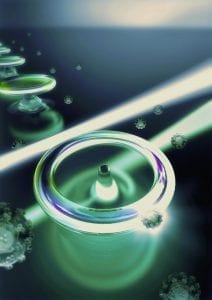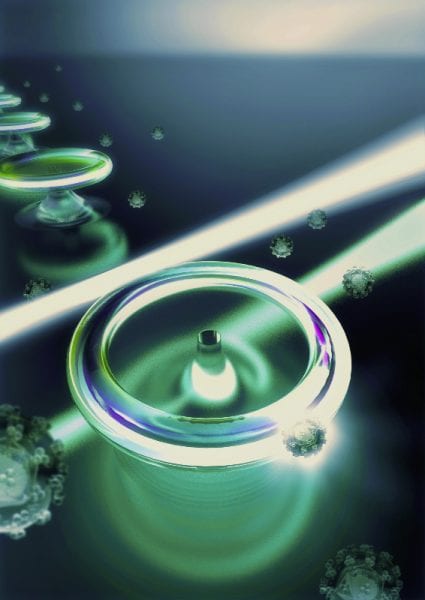 A Peking University team led by Professors Yun-Feng Xiao and Qihuang Gong, together with their colleague at the Max Planck Institute for the Science of Light in Erlangen, have developed a new sensing mechanism for single nanoscale objects and biological analytes using an optical microcavity. This can be used to effectively detect single viruses, colloidal particles, or tiny particulate matter in the air, which is crucial to a wide range of applications such as early-stage disease diagnosis, environmental monitoring, emergency response, and homeland security.
A Peking University team led by Professors Yun-Feng Xiao and Qihuang Gong, together with their colleague at the Max Planck Institute for the Science of Light in Erlangen, have developed a new sensing mechanism for single nanoscale objects and biological analytes using an optical microcavity. This can be used to effectively detect single viruses, colloidal particles, or tiny particulate matter in the air, which is crucial to a wide range of applications such as early-stage disease diagnosis, environmental monitoring, emergency response, and homeland security.
Optical resonance devices have shown great potential for ultra-sensitive optical biosensing because they greatly enhance light-matter interactions. Prominent examples are optical whispering gallery microcavities named after their acoustic equivalent, which was first explained by Lord Rayleigh when he studied “the problem of the whispering gallery” in St. Paul’s Cathedral. However, these optical devices usually detect resonance wavelength shift or mode splitting and are therefore sensitive to various noises or rely heavily on ultra-high-Q factor of microcavities. By changing the detection signal to mode linewidth broadening, the new sensing mechanism significantly reduces the effect of noise both from probing and the environment and removes the requirement for ultra-high-Q cavities while retaining high sensitivity.
In their experiments, the researchers fabricated a special polydimethylsiloxane-coated deformed microcavity to better measure the mode linewidth. When nanoparticles adhere to the surface of the microcavity, the linewidth broadens due to the nanoparticle-induced loss. Single 70-nm-in-radius polystyrene (PS) nanoparticles and about 50 nm-in-radius lentiviruses were successfully detected by this mechanism. But the device’s limit for PS nanoparticle detection is anticipated to sub-10-nm in radius, and could be further improved by combining other enhancing detection methods such as plasmonic resonance.
“It has great potential for measuring bio-nanoparticles like protein molecules, and therefore possibly paves the way for practical applications of microcavity biosensing,” said Yun-Feng Xiao, one of the leading scientists of the team.

















